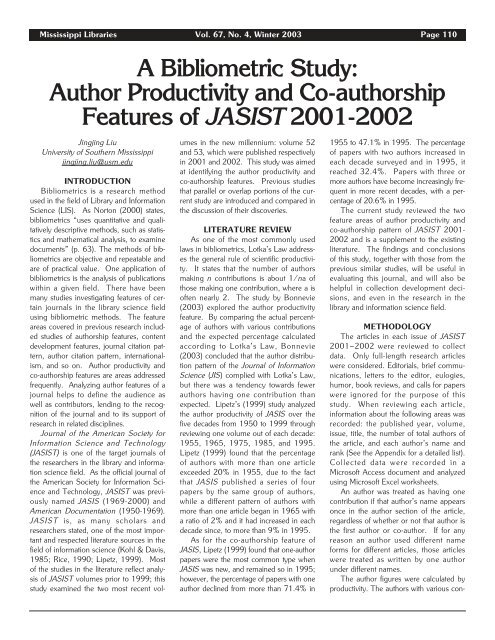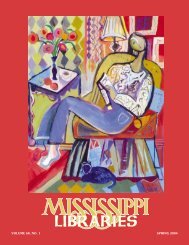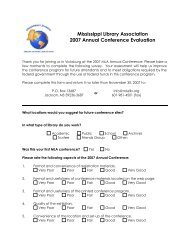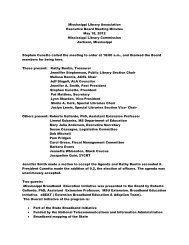Full Text (PDF) - Mississippi Library Association
Full Text (PDF) - Mississippi Library Association
Full Text (PDF) - Mississippi Library Association
Create successful ePaper yourself
Turn your PDF publications into a flip-book with our unique Google optimized e-Paper software.
<strong>Mississippi</strong> Libraries Vol. 67, No. 4, Winter 2003 Page 110<br />
A Bibliometric Study:<br />
Author Productivity and Co-authorship<br />
Features of JASIST 2001-2002<br />
Jingjing Liu<br />
University of Southern <strong>Mississippi</strong><br />
jingjing.liu@usm.edu<br />
INTRODUCTION<br />
Bibliometrics is a research method<br />
used in the field of <strong>Library</strong> and Information<br />
Science (LIS). As Norton (2000) states,<br />
bibliometrics “uses quantitative and qualitatively<br />
descriptive methods, such as statistics<br />
and mathematical analysis, to examine<br />
documents” (p. 63). The methods of bibliometrics<br />
are objective and repeatable and<br />
are of practical value. One application of<br />
bibliometrics is the analysis of publications<br />
within a given field. There have been<br />
many studies investigating features of certain<br />
journals in the library science field<br />
using bibliometric methods. The feature<br />
areas covered in previous research included<br />
studies of authorship features, content<br />
development features, journal citation pattern,<br />
author citation pattern, internationalism,<br />
and so on. Author productivity and<br />
co-authorship features are areas addressed<br />
frequently. Analyzing author features of a<br />
journal helps to define the audience as<br />
well as contributors, lending to the recognition<br />
of the journal and to its support of<br />
research in related disciplines.<br />
Journal of the American Society for<br />
Information Science and Technology<br />
(JASIST) is one of the target journals of<br />
the researchers in the library and information<br />
science field. As the official journal of<br />
the American Society for Information Science<br />
and Technology, JASIST was previously<br />
named JASIS (1969-2000) and<br />
American Documentation (1950-1969).<br />
JASIST is, as many scholars and<br />
researchers stated, one of the most important<br />
and respected literature sources in the<br />
field of information science (Kohl & Davis,<br />
1985; Rice, 1990; Lipetz, 1999). Most<br />
of the studies in the literature reflect analysis<br />
of JASIST volumes prior to 1999; this<br />
study examined the two most recent volumes<br />
in the new millennium: volume 52<br />
and 53, which were published respectively<br />
in 2001 and 2002. This study was aimed<br />
at identifying the author productivity and<br />
co-authorship features. Previous studies<br />
that parallel or overlap portions of the current<br />
study are introduced and compared in<br />
the discussion of their discoveries.<br />
LITERATURE REVIEW<br />
As one of the most commonly used<br />
laws in bibliometrics, Lotka’s Law addresses<br />
the general rule of scientific productivity.<br />
It states that the number of authors<br />
making n contributions is about 1/na of<br />
those making one contribution, where a is<br />
often nearly 2. The study by Bonnevie<br />
(2003) explored the author productivity<br />
feature. By comparing the actual percentage<br />
of authors with various contributions<br />
and the expected percentage calculated<br />
according to Lotka’s Law, Bonnevie<br />
(2003) concluded that the author distribution<br />
pattern of the Journal of Information<br />
Science (JIS) complied with Lotka’s Law,<br />
but there was a tendency towards fewer<br />
authors having one contribution than<br />
expected. Lipetz’s (1999) study analyzed<br />
the author productivity of JASIS over the<br />
five decades from 1950 to 1999 through<br />
reviewing one volume out of each decade:<br />
1955, 1965, 1975, 1985, and 1995.<br />
Lipetz (1999) found that the percentage<br />
of authors with more than one article<br />
exceeded 20% in 1955, due to the fact<br />
that JASIS published a series of four<br />
papers by the same group of authors,<br />
while a different pattern of authors with<br />
more than one article began in 1965 with<br />
a ratio of 2% and it had increased in each<br />
decade since, to more than 9% in 1995.<br />
As for the co-authorship feature of<br />
JASIS, Lipetz (1999) found that one-author<br />
papers were the most common type when<br />
JASIS was new, and remained so in 1995;<br />
however, the percentage of papers with one<br />
author declined from more than 71.4% in<br />
1955 to 47.1% in 1995. The percentage<br />
of papers with two authors increased in<br />
each decade surveyed and in 1995, it<br />
reached 32.4%. Papers with three or<br />
more authors have become increasingly frequent<br />
in more recent decades, with a percentage<br />
of 20.6% in 1995.<br />
The current study reviewed the two<br />
feature areas of author productivity and<br />
co-authorship pattern of JASIST 2001-<br />
2002 and is a supplement to the existing<br />
literature. The findings and conclusions<br />
of this study, together with those from the<br />
previous similar studies, will be useful in<br />
evaluating this journal, and will also be<br />
helpful in collection development decisions,<br />
and even in the research in the<br />
library and information science field.<br />
METHODOLOGY<br />
The articles in each issue of JASIST<br />
2001–2002 were reviewed to collect<br />
data. Only full-length research articles<br />
were considered. Editorials, brief communications,<br />
letters to the editor, eulogies,<br />
humor, book reviews, and calls for papers<br />
were ignored for the purpose of this<br />
study. When reviewing each article,<br />
information about the following areas was<br />
recorded: the published year, volume,<br />
issue, title, the number of total authors of<br />
the article, and each author’s name and<br />
rank (See the Appendix for a detailed list).<br />
Collected data were recorded in a<br />
Microsoft Access document and analyzed<br />
using Microsoft Excel worksheets.<br />
An author was treated as having one<br />
contribution if that author’s name appears<br />
once in the author section of the article,<br />
regardless of whether or not that author is<br />
the first author or co-author. If for any<br />
reason an author used different name<br />
forms for different articles, those articles<br />
were treated as written by one author<br />
under different names.<br />
The author figures were calculated by<br />
productivity. The authors with various con-














